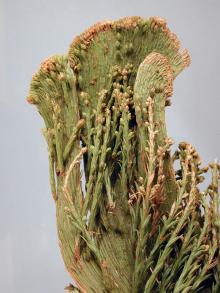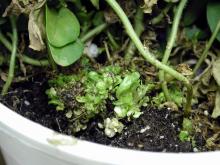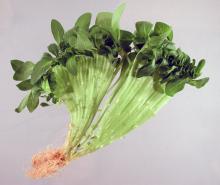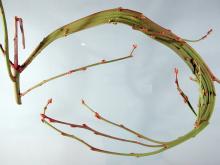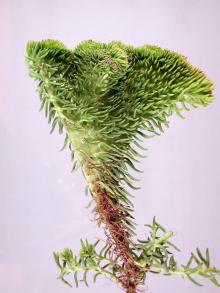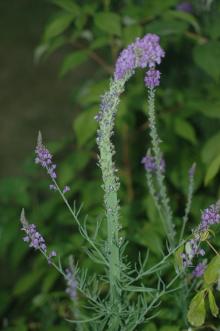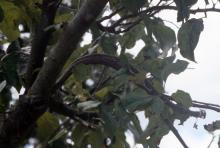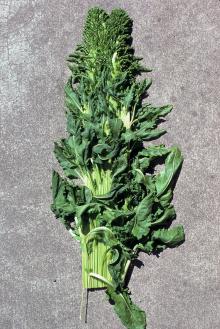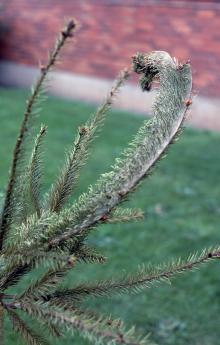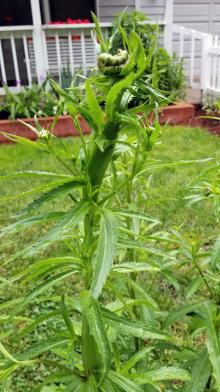Fasciation has been defined as a distortion of a plant caused by an injury or infection that results in thin, flattened, and sometimes curved shoots. Most fasciations that come to mind by this definition are due to disruptions of the apical bud caused by physical injury, chemicals, mutations, or a genetically inherited trait, however, bacterial infections may also be responsible. Fasciation has been observed in Oregon on apple, asparagus, cherry, lily, maple, Pinus spp., and sugar beet flower heads. It also has been reported on birch, flowering cherry, daphne, elm, geranium, grape, green ash, poplar, potato, snapdragon, strawberry, sweet potato, and tomato. The Ogi Japanese Black Pine (Pinus thunbergii ‘Ogi’) will consistently produce new growth or “candles” with a cockscomb-like terminal growth.
Genetic fasciation is of the “ribbon” type, where the tissue grows in two opposite directions, like a piece of ribbon held horizontally. This abnormal flattening is usually on stems but can be from any part of the plant. Stem width varies so that the stem looks ribbed, somewhat as if several stems had fused along their sides. The stem may be bent or coiled in different directions. Normal stems may seem to be produced at one end or on the side. An example of this is cockscomb celosia. Sometimes the tissue can grow in a fan shape, as is often seen with woody plants, and it is always on a terminal part of the plant. Leaves or needles also may be produced and can vary from normal size to dwarfed. These mutations can be transmitted vegetatively or sexually, through seed. An abnormal growing point arises from cell divisions stimulated by any one of many causes. A characteristic property of these divisions is that periclinal cell walls (parallel to the meristem) divisions are formed instead of anticlinal (perpendicular to the meristem). A vegetative ridge is produced, which gives rise to a typical fasciation. When the ridge is first formed, tensions between the different zones in the growing point maintain the ridge-shaped structure. No differentiation of new tissue occurs, nor is the ratio between the various tissues altered. A fasciated stem differs from a normal one only in the shape and greater volume of the various tissues.
Bacterial fasciation by Rhodococcus fascians is a bit different as it occurs when multiple buds are formed that only partially expand, producing a dense cluster of growth called a leafy gall. Leafy galls can occur below the soil surface, at the base of the plant, or on any portion of the plant and is not limited to a terminal branch. The leading hypothesis suggests Rhodococcus secretes cytokinins to cause leafy galls. Rhodococcus fascians has not been recovered from woody plants with ribbon-like fasciation.
In general, there is no need for control or management of ribbon fasciations. Abiotic causes will not spread to other plants. The damage, if that is how it is viewed, is all that will occur. Remove unwanted stems or plants if desired.
Disease management for bacterial fasciation depends on prevention. Once the plant is introduced into a greenhouse, sanitation is extremely important. Start with clean plants and do not take cuttings from symptomatic plants or plants in close proximity to diseased plants. Use disease-indexed, tissue-culture-derived plants for those cultivars that appear particularly susceptible. Use new planting trays and pots. Potting mix or field soil should be pasteurized before use. Knives or razor blades should be changed or sterilized between plants during propagation. Bench tops should allow water to drain freely. Immediately remove and destroy any diseased plants plus any neighboring plants or trays. Clean up and discard all old leaves and other plant debris. There have been no chemical trials conducted to determine efficacy of control compounds. Grower experience; however, has indicated that using copper-based products on plants may be useful under some conditions such as protection of uninfected plants.
References
Geneve, R. 1990. Fascinated with fasciations. American Horticulturist 69(8):26-31.
Gorter, C.J. 1965. Origin of fasciation. p. 1977–1998 in Differenzierung und Entwicklung/Differentiation and Development. Berlin, Heidelberg: Springer.
Horst, R.K. 2013. Westcott’s Plant Disease Handbook, 8th ed. Netherlands: Springer Science+Business Media.
Putnam, M.L, and Miller, M.L. 2007. Rhodococcus fascians in herbaceous perennials. Plant Disease 91: 1064-1076.
Sinclair, W.A., Lyon, H.H., and Johnson W.T. 1987. Diseases of Trees and Shrubs. Ithaca, NY: Cornell University Press.
White, O.E. 1948. Fasciation. The botanical review 14:319-358.


